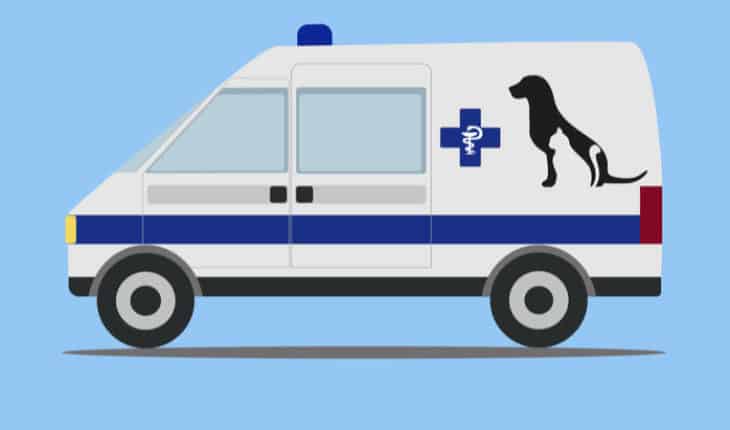What to do if your dog is hit by a car? Dogs and cats are unpredictable. They can suddenly run into the road if scared or dash across street if distracted by something on the other side. Additionally, being low to the ground means pets are often out of the direct line of vision of drivers or cyclists. The result is that road traffic collisions involving dogs and cats often occur, through no fault of the pet or driver. This can be worrying for drivers and devastating for the person whose pet is injured or killed and pretty distressing for the pet too.
Here’s a step by step guide to what to do if your pet is hit by a car, or if you are a driver who accidentally kills or injures an animal in the road.
If you are a driver and you hit a dog
You must stop
If you’re involved in an accident and an animal is injured you must stop the car. This is the case whether the animal is on the road, in another vehicle, or even if the accident wasn’t your fault.
The law
The Road Traffic Act 1988 states that if you hit one of the animals covered by the law – which includes dogs, goats, horses, cattle, donkeys, mules, sheep and pigs – you are legally required to report it to the police.
For animals not mentioned in the Road Traffic Act– such as a cat or a fox – you aren’t legally required to report the incident, but you might want to inform the police anyway.
It would be kind to try and locate the owner of the pet if possible.
However, Cats Matter is campaigning to take the Cats Bill through Parliament. This bill presses for a change to the Road Traffic Act (1988) making it a legal requirement that any driver involved in an accident resulting in injury or death to a cat to stop and give information or report the accident to the police. They are raising funds for councils to scan and report cars who have hit cats and failed to stop.
It is estimated that there are around 230,000 cats killed on the road in the UK every year.
Why are dogs covered by the law – but not cats?
Dogs are considered to be working animals and that is why they are included and not cats.
Remain at the scene
For animals covered by the law – You must remain with your car at the scene long enough for any other parties involved to ask for details if they are required. These other parties could be the owner of the injured animal, the RSPCA or the police.
Approaching the animal
Put your safety first – watch out for vehicles or other hazards that could put you or anyone else in danger.
Before approaching an injured animal, remember it is likely to be scared and could try to bite or scratch you.
Contact the owner if you suspect you have hit someone’s pet, try and find its collar so you can alert the owner as to what has happened.
Call the police if necessary
Remember if you hit a dog or other animal mentioned in the Road Traffic Act 1988 you are legally required to inform the police.
If the dog isn’t wearing a tag and you are unable to trace its owner, you have to report the incident to a police officer or at your local police station within 24 hours.
Vet
If the animal needs urgent medical attention, the police can often provide a list of vets available to attend. If you take the animal to the vet, you should not be responsible for paying the vets fees.
RSPCA
The RSPCA operate a 24-hour advice line number to call for guidance: 0300 1234 999
What to do if your dog or cat is injured by a car?
If you are the first on scene at a road traffic collision involving a dog or cat here’s a step-by-step guide of how best to help.
Prevention is key
To avoid an accident happening in the first place, always ensure that your dog is on a short lead when walking close to traffic.
Think carefully when opening the front door, to reduce the chances of your dog or cat bolting into the road. If you are visiting someone else’s house or just out and about with your pet, think carefully to ensure they remain safe from potential danger.
If an accident does happen:
The initial priority is:
- your own safety
- the safety of other humans
- the injured animal
Make sure that all traffic has stopped and the accident is clearly flagged to others. Otherwise there could easily be additional casualties. If you get injured while rushing to help your pet, you’ll be unable to assist them, so take time to ensure the scene is safe before doing anything else at all.
Human safety and human casualties always take priority.
- If there is any fuel spillage or potential fire risk – turn off car ignitions. Put on hazard lights and encourage other cars to do the same.
- Stay as calm as you can. Stress and panic will make things worse for the injured animal.
- If it is possible to do so, use a parcel shelf or some other flat support and very carefully remove your pet from the road and further danger, doing your best to avoid twisting their spine.
See below for how to safely move a dog or cat if you suspect they could have a spinal injury.
- Reassure your pet – keep them warm and dry and look out for signs that they could be going into shock. Early signs of shock can be deep red tacky gums, deteriorating levels of consciousness. If you suspect they may be going into shock, it can be helpful to raise their bottom and lower limbs.
- Keep your pet warm by wrapping them in a blanket, coat or foil blanket
Ensure their nose and mouth exposed, loosen their collar if it could be constricting their airway..
- Try and stop any obvious bleeding by applying firm pressure to the wound.
- If they are unconscious and breathing, very carefully roll them into the recovery position.
- Phone your vet or the nearest veterinary surgery and get urgent help and advice.
The vet will want to know:
- what has happened?
- are there any obvious injuries?
- where the animal is now and do you need to move them to allow traffic to begin moving again?
The vet is likely to give you advice as to how to stabilise particular injuries and the best way to move the animal.
Consider muzzling your dog if there is a risk of you being bitten
Be aware that injured animals will be scared and in pain. Dogs in pain and frightened are likely to bite, even if they know and love you, so an emergency muzzle can be made with some bandage or tape to loop over the dog’s nose before transporting or handling.
Only use a muzzle if the animal is not having breathing difficulties and is not at risk of vomiting.
Moving your pet
Support their head and neck and carefully roll them, ideally onto a stiff board, car parcel shelf, or blanket to transfer them into the car.

Roll them onto the improvised stretcher to transport them – avoiding twisting their spine.
Everyone on the road should have a suitably stocked first aid kit and know how to use its contents. Most of the contents of a human first aid kit can be useful to a dog in a medical emergency – but never give any human medication to a dog or cat without veterinary instructions to do so.
If your pet is having difficulty breathing
- Remove their collar, open their mouth and check for any obstructions.
- If they are unconscious and breathing, place on their right-hand side in the recovery position.
Do not give them any food or drink
Do not give food or drink to an injured animal in case they need an anaesthetic.
However, if there will be a delay getting veterinary treatment and your pet is distressed and dehydrated, on veterinary advice they may be given small amounts of water.
Do not give any medication unless directed to do so by the vet.
If your pet has a head injury
Head injuries in dogs and cats can be extremely serious.
Phone a local vet immediately, keep the animal warm and carefully transport them to the Veterinary Surgery. All pets that have experienced a head injury should be checked by a vet.
A bang on the head can cause them to have a seizure
If they have a seizure, you should protect them from further danger; phone the vet, dim lights and remain as quiet as possible whilst the seizure continues, put them in the recovery position once the seizure finishes.
Head wounds can bleed profusely – don’t panic!
The head and face are extremely vascular and consequently bleed profusely. Try not to panic, you will probably find that once you have applied firm pressure for 10 minutes that the wound is not nearly as bad as you feared.
Always call your vet.
EBOOK: EMERGENCY TIPS & TECHNIQUES TO SAVE YOUR DOG’S LIFE CLICK HERE.
We cover care of a dog that has been hit by a car, on all our practical and online dog first aid courses.
- What is a seizure? - 13th March 2025
- Febrile Convulsions and Seizures in Children - 13th March 2025
- Why women are less likely to receive CPR or survive cardiac arrest - 6th March 2025







